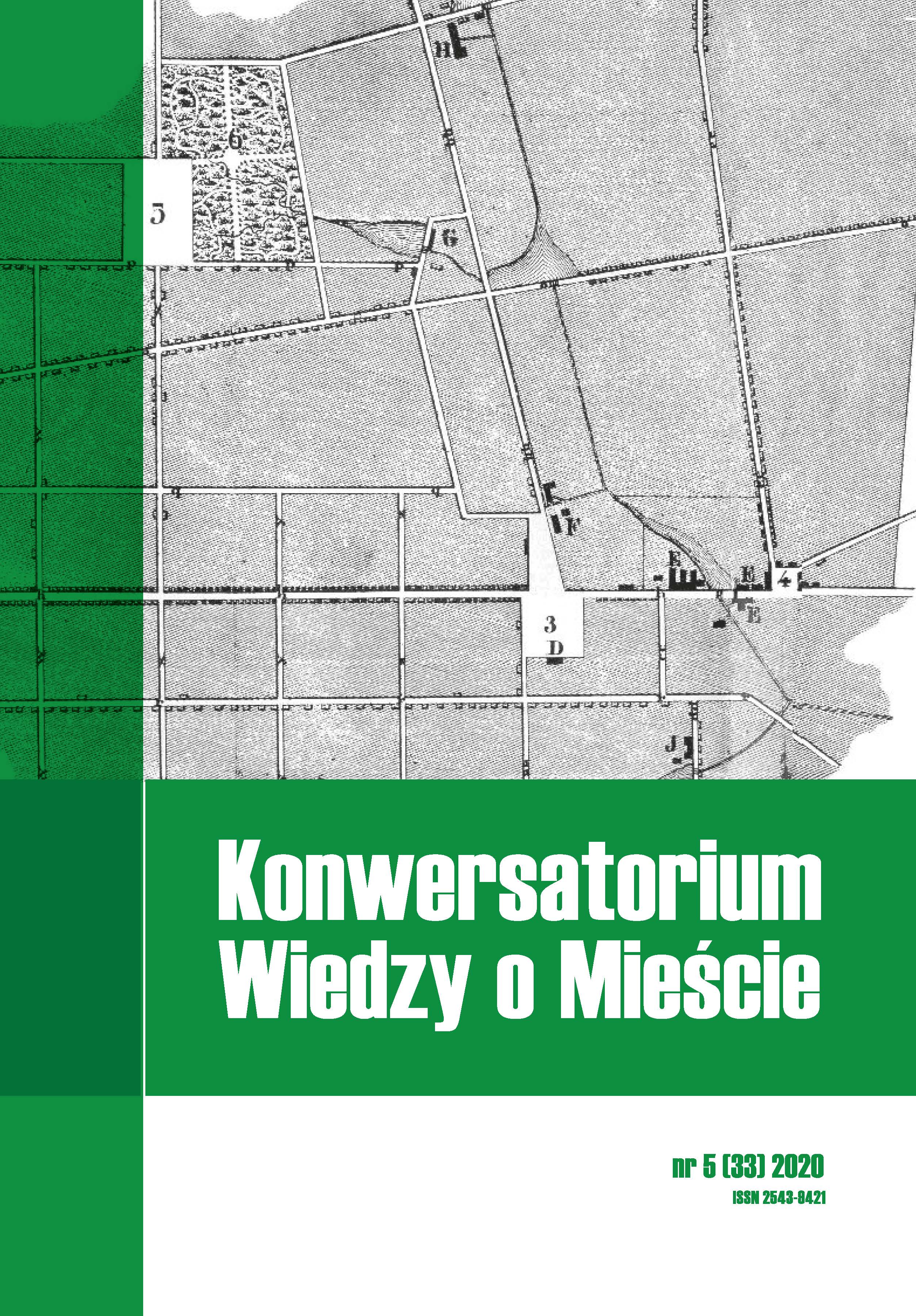Urban network in Poland during last millennium
DOI:
https://doi.org/10.18778/2543-9421.05.01Keywords:
urban network, urbanization, historical and geographical perspective, PolandAbstract
The article attempts to find in the history of Poland facts and processes that influenced the contemporary shape of the Polish urban network. In comparison with other parts of Europe, the process of urbanisation in Central and Eastern Europe was significantly delayed. During the last millennium, the Polish state changed its borders many times, mainly in the east-west direction, because the Baltic Sea from the north and the Sudeten and Carpathian ranges from the south effectively inhibited territorial changes in the north-south direction. The process of shaping and strengthening the urban settlement network in Poland to the present day has been divided into five periods. The first, lasting from the 8th century until the union of Kreva in 1385, encompasses the beginnings of the establishment and spreading of urban settlement network; the second – the merger of the urban network with the Grand Duchy of Lithuania and its strengthening in the joint state; the third – the disappearance of Poland from the map of Europe and the breakup of the settlement network into three parts: tsarist Russia, the Habsburg monarchy, Prussia, and the start of industrialisation of the partitioned land; the fourth refers to the period when Poland, after 123 years, reappeared on the administrative map of Europe (1918-1939); and the fifth one covers the period from 1945 to the present day. When undertaking scientific research on the contemporary urban network of Poland, many political, social and economic factors should be taken into account. These should be taken into account when making hypotheses, drawing conclusions and developing economic and geographical theories.
References
Aldcroft, D.H. (2006). Europe’s third world. Ashgate publishing. London: Routledge. https://doi.org/10.4324/9781315581156
Google Scholar
DOI: https://doi.org/10.4324/9781315581156
Anderson, G., Ge, Y. (2005). The size distribution of Chinese cities. Regional Science and Urban Economics, 35 (6), 756-776. https://doi.org/10.1016/j.regsciurbeco.2005.01.003
Google Scholar
DOI: https://doi.org/10.1016/j.regsciurbeco.2005.01.003
Antrop, M. (2004). Landscape change and the urbanization process in Europe. Landscape and Urban Planning, 67 (1-4), 9-26. https://doi.org/10.1016/S0169-2046(03)00026-4
Google Scholar
DOI: https://doi.org/10.1016/S0169-2046(03)00026-4
Balcerowicz, L. (1994). Transition to the market economy: Poland, 1989-1993 in comparative perspective. Economic Policy, 9 (19), 71-97. https://doi.org/10.2307/1344601
Google Scholar
DOI: https://doi.org/10.2307/1344601
Bretagnolle, A., Pumain, D. (2010). Simulating urban networks through multiscalar space-time dynamics (Europe and United States, 17th-20th Centuries). Urban Studies, 47 (13), 2819-2839. https://doi.org/10.1177/0042098010377366
Google Scholar
DOI: https://doi.org/10.1177/0042098010377366
Czaja, R. (2000). Miasta i ich posiadłości ziemskie w państwie zakonu krzyżackiego w Prusach. In: H. Nowak, R. Czaja (eds), Państwo zakonu krzyżackiego w Prusach. Podziały administracyjne i kościelne w XIII–XVI wieku (pp. 45-65). Toruń: Wydawnictwo Naukowe Uniwersytetu Mikołaja Kopernika.
Google Scholar
Długosz, Z. (2006). Migration of population in big Polish cities as compared to smaller cities and towns in the light ofselected parameters of the migration process. Bulletin of Geography, 6, 33-50. Retrieved from: http://www.bulletinofgeography.umk.pl/6_2006/03_dlugosz.pdf (14.01.2021).
Google Scholar
Dziewoński, K. (1947). Przeobrażenia osadnictwa miejskiego w Polsce. Czasopismo Geograficzne, 18 (1-4), 202-231.
Google Scholar
Frey, W.H., Zimmer, Z. (2001). Defining the city. In: R. Paddison (ed.), Handbook of urban studies (pp. 14-34). London, Thousand Oaks, New Delhi: Sage. https://doi.org/10.4135/9781848608375.n2
Google Scholar
DOI: https://doi.org/10.4135/9781848608375.n2
Grabowski, E. (1914). Skupienia miejskie w Królestwie Polskiem. Warszawa: Skład Główny w Księgarni E. Wende S-ka.
Google Scholar
Guerin-Pace, F., Pumain, D. (1990). 150 Ans de croissance urbaine. Economie et Statistique, 230, 5-16. https://doi.org/10.3406/estat.1990.5426
Google Scholar
DOI: https://doi.org/10.3406/estat.1990.5426
Hall, P.G., Pain, K. (eds) (2009). The polycentric metropolis: Learning from mega-city regions in Europe. The polycentric metropolis (earthscan). London: Routledge. https://doi.org/10.4324/9781849773911
Google Scholar
DOI: https://doi.org/10.4324/9781849773911
Hartwell, C.A. (2018). The “hierarchy of institutions” reconsidered: Monetary policy and its effect on the rule of law in interwar Poland. Explorations in Economic History, 68, 37-70. https://doi.org/10.1016/j.eeh.2018.03.001
Google Scholar
DOI: https://doi.org/10.1016/j.eeh.2018.03.001
History of the Jagiellonian University (2019). Retrieved from: https://en.uj.edu.pl/en_US/about-university/history (20.06.2019).
Google Scholar
Jażdżewska, I. (2001). Miejska sieć osadnicza i jej przemiany. In: S. Liszewski (ed.) Zarys monografii województwa łódzkiego (pp. 225-240). Łódź: Łódzkie Towarzystwo Naukowe.
Google Scholar
Jażdżewska, I. (2006). Factors determining changes in urban settlement system in Poland in the 20th century. Acta Facultatis Studiorum Humanitatis et Nature Universitatis Presoviensis. Folia Geographica, 10, 217-223.
Google Scholar
Jażdżewska, I. (2008). Przemiany miejskiej sieci osadniczej w Polsce w świetle metod matematycznych. Łódź: Wydawnictwo Uniwersytetu Łódzkiego.
Google Scholar
Jażdżewski, K. (1957). Kształtowanie się wczesnośredniowiecznej kultury miejskiej w Polsce w świetle badań w latach 1945-1954. In: Pierwsza sesja archeologiczna IHKM PAN (pp. 319-347). Warszawa–Wrocław: Zakład im. Ossolińskich.
Google Scholar
Jelonek, A. (1967). Niektóre problemy sieci miast na ziemiach Polski na początku XIX wieku. Zeszyty Naukowe Uniwersytetu Jagiellońskiego. Prace Geograficzne, 15, 95-112.
Google Scholar
Kalinowski, W. (1986). Rozwój miast w Polsce. In: W. Zin (ed.), Zabytki urbanistyki i architektury w Polsce. Odbudowa i konserwacja. Vol. 1: Miasta historyczne. Warszawa: Ośrodek Dokumentacji Zabytków.
Google Scholar
Kawashima, T., Korcelli, P. (eds) (1982). Human settlement systems: Spatial patterns and trends. Population and Development Review, 8 (4), 857-858. https://doi.org/10.2307/1972484
Google Scholar
DOI: https://doi.org/10.2307/1972484
Koter, M., Kulesza, M. (1997). The historical background of the social and economic changes within small towns in Poland. In: K. Heffner, M. Ravbar (eds), Small European regions during transition period transformation of settlement systems (pp. 9-35). Opole: Instytut Śląski w Opolu.
Google Scholar
Koter, M., Kulesza, M. (2001). Geographical and historical grounds of formation of borders of former and present-day Poland. In: M. Koter, K. Heffner (eds), Changing role of border areas and regional policies, region and regionalism (pp. 165-179).Łódź–Opole: Państwowy Instytut Nukowy, Instytut Śląski w Opolu. Retrieved from: http://geopol.geo.uni.lodz.pl/uploads/files/region-and-regionalism/R-and-R-05.pdf (15.01.2021).
Google Scholar
Krzymowska-Kostrowicka, A. (1972). The impact of the railway on the development of Polish towns from 1860 to 1910. Geographia Polonica, 21, 53-61.
Google Scholar
Krzysztofik, R. (2007). Lokacje miejskie na obszarze Polski: dokumentacja geograficzno-historyczna. Katowice: Wydawnictwo Uniwersytetu Śląskiego.
Google Scholar
Krzysztofik, R., Szmytkie, R. (2005). Proces ksztaltowania się sieci miejskiej w Polsce w okresie od XIII do XX wieku. Czasopismo Geograficzne, 76 (4), 383-398.
Google Scholar
Krzyżanowski, K., Kumaniecki, K. (1915). Statystyka Polska. Kraków: Skład Główny w Księgarni G. Gebethnera.
Google Scholar
Kulesza, M., Kunka, T. (1994). Regions of Poland from historical perspectives – some selected remarks. Territories and boundaries from beginning of Polish statehood (966) to the partitions of Poland (1975). In: M. Koter (ed.), Inner divisions. Region and regionalism (pp. 97-102). Łódź–Opole: Univeristy of Lodz; Siliesian Institute in Opole.
Google Scholar
Kwiatek-Sołtys, A. (2011). Small towns in Poland – barriers and factors of growth. Procedia – Social and Behavioral Sciences, 19, 363-370. https://doi.org/10.1016/j.sbspro.2011.05.143
Google Scholar
DOI: https://doi.org/10.1016/j.sbspro.2011.05.143
Lijewski, T. (1977). Geografia Transportu. Warszawa: Państwowe Wydawnictwo Ekonomiczne.
Google Scholar
Moomaw, R.L., Shatter, A.M. (1996). Urbanization and economic development: A bias toward large cities? Journal of Urban Economics, 40 (1), 13-37. https://doi.org/10.1006/juec.1996.0021
Google Scholar
DOI: https://doi.org/10.1006/juec.1996.0021
Murzyn-Kupisz, M., Gwosdz, K. (2011). The changing identity of the central european city: The case of Katowice. Journal of Historical Geography, 37 (1), 113-126. https://doi.org/10.1016/j.jhg.2010.04.001
Google Scholar
DOI: https://doi.org/10.1016/j.jhg.2010.04.001
Musiaka, Ł. (2015). Teutonic state order’s cultural heritage in towns of Warmia-Masuria province in Poland. Geografické Informácie, 18 (2), 138-146. https://doi.org/10.17846/gi.2014.18.2.138-146
Google Scholar
DOI: https://doi.org/10.17846/GI.2014.18.2.138-146
Rykiel, Z., Jażdżewska, I. (2002). The maturing of the Polish urban system. In: H.S. Geyer (ed.), International handbook of urban systems (pp. 271-294). Cheltenham, Northampton: Edward Elgar.
Google Scholar
Samsonowicz, H. (1980). Tendencje rozwoju sieci miejskiej w Polsce późnośredniowiecznej. Kwartalnik Historii Kultury Materialnej, 28 (3), 341-348.
Google Scholar
Samsonowicz, H. (2010). The rise and fall of the world of economy: Eastern Europe in 9th-12th centuries. Journal of World-Systems Research, 6 (2), 518-523. https://doi.org/10.5195/jwsr.2000.215
Google Scholar
DOI: https://doi.org/10.5195/jwsr.2000.215
Śleszyński, P. (2013). Demographic changes in the functional urban areas in Poland, 2000-2010. Geographia Polonica, 86 (2), 169-170. https://doi.org/10.7163/gpol.2013.16
Google Scholar
DOI: https://doi.org/10.7163/GPol.2013.16
The Central Statistical Office. Retrieved from: https://stat.gov.pl/ (30.06.2018).
Google Scholar
Wegener, M. (2013). Polycentric Europe: More efficient, more equitable and more sustainable? International Seminar on Welfare and Competitiveness in the European Polycentric Urban Structure, 7 June 2013, Florence.
Google Scholar
Wolf, N. (2005). Path dependent border effects: The case of Poland’s reunification (1918-1939). Explorations in Economic History, 42, 414-438. https://doi.org/10.1016/j.eeh.2004.10.002
Google Scholar
DOI: https://doi.org/10.1016/j.eeh.2004.10.002
Wolf, N. (2007). Endowments vs. market potential: What explains the relocation of industry after the Polish reunification in 1918? Explorations in Economic History, 44, 22-42. https://doi.org/10.1016/j.eeh.2005.08.003
Google Scholar
DOI: https://doi.org/10.1016/j.eeh.2005.08.003
Zuzańska-Zyśko, E. (2003). Population types of small towns in Silesian province. Bulletin of Geography, 2, 143-149.
Google Scholar
Downloads
Published
How to Cite
Issue
Section
License

This work is licensed under a Creative Commons Attribution-NonCommercial-NoDerivatives 4.0 International License.









